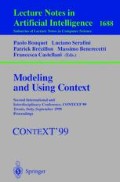Abstract
This paper presents the outline of a formal ontology of contexts. More specifically, it deals with the ontology of ecological contexts (niches, habitats, environments, ambients) and of the relations between organisms, niches, and the spatial regions they occupy. The first part sets out the basic conceptual background. The second part outlines a semi-formal theory which builds upon notions and principles of mereology, topology, and the theory of spatial location.
Access this chapter
Tax calculation will be finalised at checkout
Purchases are for personal use only
Preview
Unable to display preview. Download preview PDF.
References
Barker, R. G., 1968, Ecological Psychology. Concepts and Methods for Studying the Environment of Human Behavior, Stanford: Stanford University Press.
Barker, R. G., and Associates, 1978, Habitats, Environments, and Human Behavior, San Francisco: Jossey-Bass Publishers.
Bruggeman, J. P., 1996, Formalizing Organizational Ecology. Logical and Mathematical Investigations in Organization Theory, Dissertation, Center for Computer Science in Organization and Managenemt, University of Amsterdam.
Cardelli, L., and Gordon, A. D., 1998, ‘Mobile Ambients”, in M. Nivat (ed.), Foundations of Software Science and Computational Structures. Proceedings of the First International Conference, Berlin and Heidelberg: Springer-Verlag, pp. 140–155.
Cartwright, R., 1975, ‘Scattered Objects”, in K. Lehrer (ed.), Analysis and Metaphysics, Dordrecht: Reidel, pp. 153–171.
Casati, R., and Varzi, A. C., 1994, Holes and Other Superficialities, Cambridge, MA, and London: MIT Press (Bradford Books).
Casati, R., and Varzi, A. C., 1996, ‘The Structure of Spatial Location’, Philosophical Studies 82, 205–239.
Casati, R., and Varzi, A. C., 1997, ‘Spatial Entities”, in O. Stock (ed.), Spatial and Temporal Reasoning, Dordrecht, Boston, and London: Kluwer Academic Publishers, pp. 73–96.
Casati, R., and Varzi, A. C., 1999, Parts and Places: The Structures of Spatial Representation, Cambridge, MA, and London: MIT Press (Bradford Books).
Cohn, A. G., and Varzi, A. C., 1998, ‘Connection Relations in Mereotopology’, in H. Prade (ed.), Proceedings of the 13th European Conference on Artificial Intelligence, Chichester: John Wiley & Sons, pp. 150–154.
Cohn, A. G., and Varzi, A. C., 1999, ‘Modes of Connection’, in C. Freksa (ed.), Spatial Information Theory. Proceedings of the Fourth International Conference, Berlin and Heidelberg: Springer-Verlag, in press.
Damuth, J., 1985, ‘Selection among “Species”: A Formulation in Terms of Natural Functional Units’, Evolution 39, 1132–1146.
Eldredge, N., 1989, Macroevolutionary Dynamics: Species, Niches, and Adaptive Peaks, New York: McGraw-Hill.
Elton, C., 1927, Animal Ecology, New York: Macmillan.
Freeman, J., and Hannan, M. T., 1983, ‘Niche Width and the Dynamics of Organizational Populations”, American Journal of Sociology 88, 1116–1145.
Gibson, J. J., 1979, The Ecological Approach to Visual Perception, Boston: Houghton-Mifflin.
Hall, E. T., 1966, The Hidden Dimension, Garden City: Doubleday.
Heller, M., 1996, ‘Against Metaphysical Vagueness’, Philosophical Perspectives 10, 177–186.
Hutchinson, G. E., 1978, An Introduction to Population Ecology, New Haven: Yale University Press.
Johansson, I., 1998, ‘Pattern as an Ontological Category’, in N. Guarino (ed.), Formal Ontology in Information Systems, Amsterdam: IOS Press, pp. 86–94.
Lewontin, R., 1979, ‘Sociobiology as an Adaptationist Program’, Behavioral Science 24, 5–14.
Looijen, R. C., 1995, ‘On the Distinction Between Habitat and Niche, and Some Implications for Speciesí Differentiation’, in T. A. F. Kuipers and A. R. Mackor (eds.), Cognitive Patterns in Science and Common Sense, Amsterdam and Atlanta: Rodopi, pp. 87–108.
Milne, G. R., 1990, An Ecological Niche Theory Approach to the Assessment of Brand Competition in Fragmented Markets, Dissertation, School of Business Administration, University of North Carolina at Chapel Hill.
Sack, R. D., 1986, Human Territoriality. Its Theory and History, Cambridge: Cambridge University Press.
Schoggen, P., 1989, Behavior Settings. A Revision and Extension of Roger G. Barker’s Ecological Psychology, Stanford: Stanford University Press.
Smith, B., 1995, ‘On Drawing Lines on a Map”, in A. U. Frank and W. Kuhn (eds.), Spatial Information Theory. A Theoretical Basis for GIS, Berlin and Heidelberg: Springer-Verlag, pp. 475–84.
Smith, B., 1996, ‘Mereotopology: A Theory of Parts and Boundaries’, Data and Knowledge Engineering 20, 1996, 287–304.
Smith, B., 1997, ‘Boundaries: An Essay in Mereotopology’, in L. H. Hahn (ed.), The Philosophy of Roderick Chisholm (Library of Living Philosophers), Chicago and La Salle, IL: Open Court, pp. 534–61.
Smith, B., 1999, ‘Objects and Their Environments: From Aristotle to Ecological Psychology’, in A. Frank (ed.), The Life and Motion of Socioeconomic Units, London: Taylor and Francis, in press.
Smith, B., and Varzi, A. C., 1999a, ‘The Niche’, Noûs 33, 198–222.
Smith, B., and Varzi, A. C., 1999b, ‘Fiat and Bona Fide Boundaries’, Philosophy and Phenomenological Research, in press.
Sterelny, K., and Griffiths, P., 1999, Sex and Death: An Introduction to the Philosophy of Biology, Chicago: University of Chicago Press.
Taylor, R. B., 1988, Human Territorial Functioning. An Empirical, Evolutionary Perspective on Individual and Small Group Territorial Cognitions, Behaviors and Consequences, Cambridge: Cambridge University Press.
Tye, M., 1990, ‘Vague Objects’, Mind 99, 535–557.
Varzi, A. C., 1996a, ‘Parts, Wholes, and Part-Whole Relations: The Prospects of Mereotopology,’ Data and Knowledge Engineering 20, 259–86.
Varzi, A. C., 1996b, ‘Reasoning about Space: The Hole Story’, Logic and Logical Philosophy 4, 3–39.
Varzi, A. C., 1997, ‘Boundaries, Continuity, and Contact’, Noûs 31, 26–58.
Varzi, A. C., 1998, ‘Basic Problems of Mereotopology”, in N. Guarino (ed.), Formal Ontology in Information Systems, Amsterdam: IOS Press, pp. 29–38.
Whittaker, R. H., and Lewin, S. A. (eds.), 1975, Niche Theory and Applications (Benchmark Papers in Ecology 3), Stroudsburg, PA: Dowden, Hutchinson, and Ross.
Author information
Authors and Affiliations
Editor information
Editors and Affiliations
Rights and permissions
Copyright information
© 1999 Springer-Verlag Berlin Heidelberg
About this paper
Cite this paper
Smith, B., Varzi, A.C. (1999). The Formal Structure of Ecological Contexts. In: Bouquet, P., Benerecetti, M., Serafini, L., Brézillon, P., Castellani, F. (eds) Modeling and Using Context. CONTEXT 1999. Lecture Notes in Computer Science(), vol 1688. Springer, Berlin, Heidelberg. https://doi.org/10.1007/3-540-48315-2_26
Download citation
DOI: https://doi.org/10.1007/3-540-48315-2_26
Published:
Publisher Name: Springer, Berlin, Heidelberg
Print ISBN: 978-3-540-66432-1
Online ISBN: 978-3-540-48315-1
eBook Packages: Springer Book Archive

